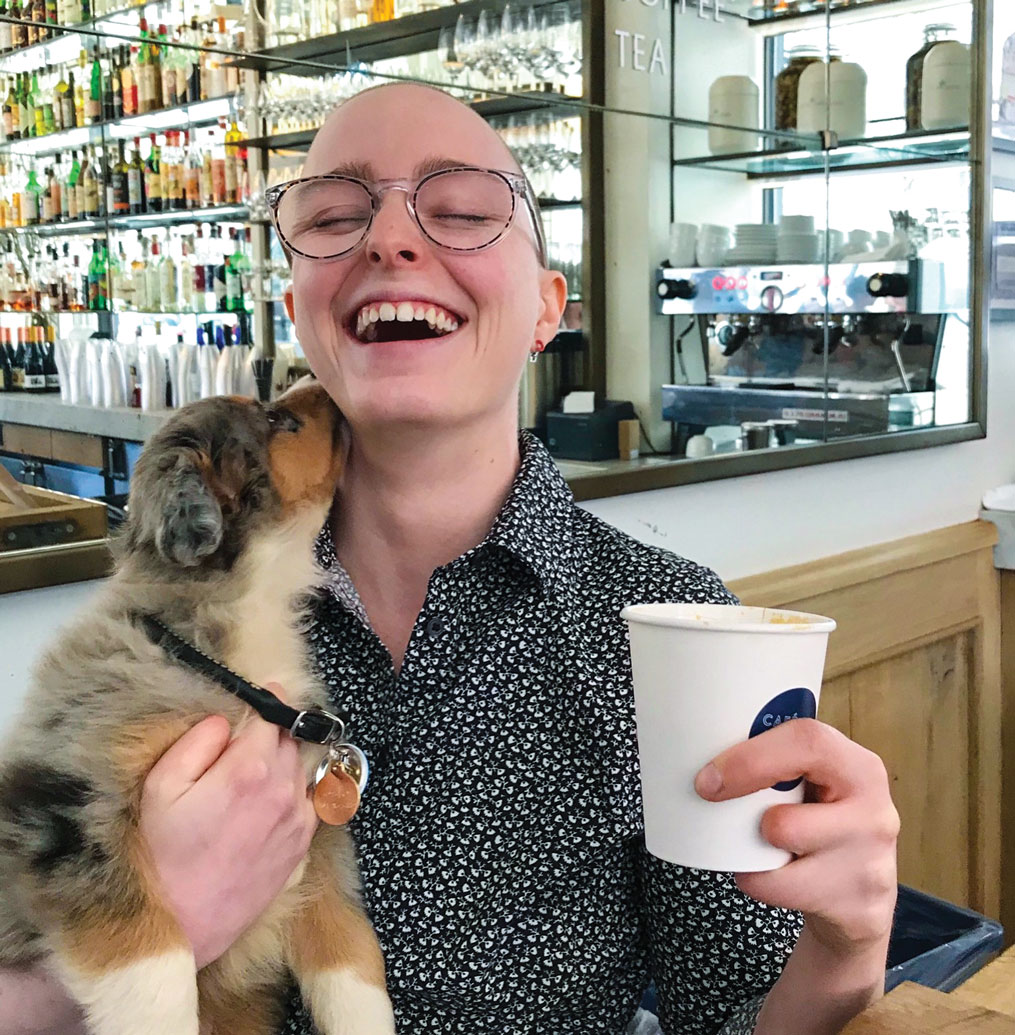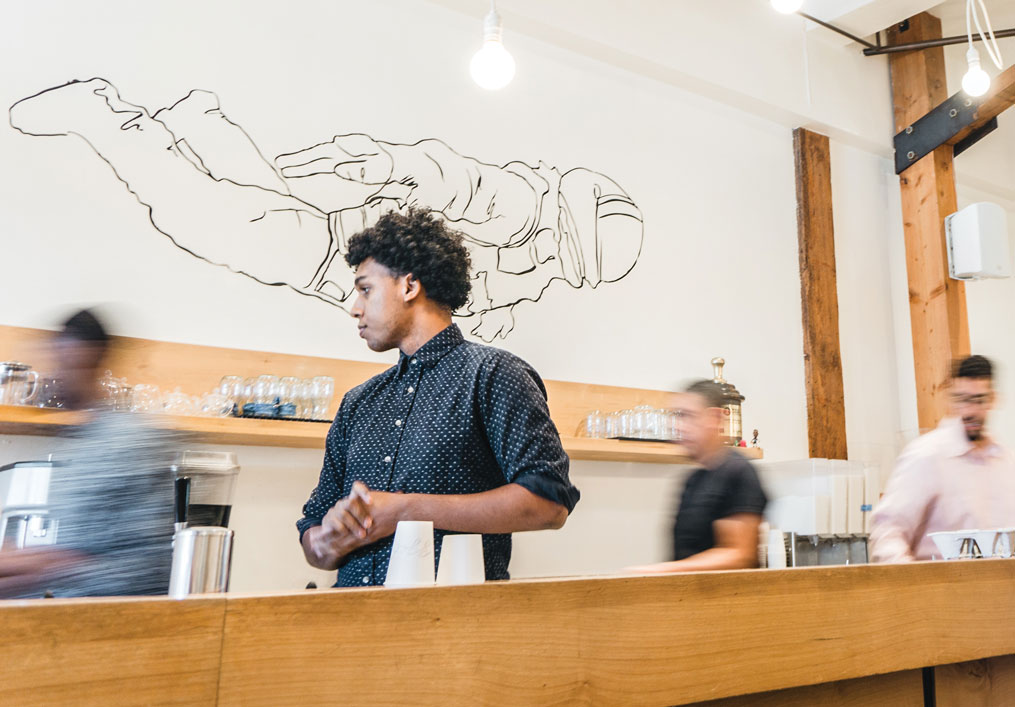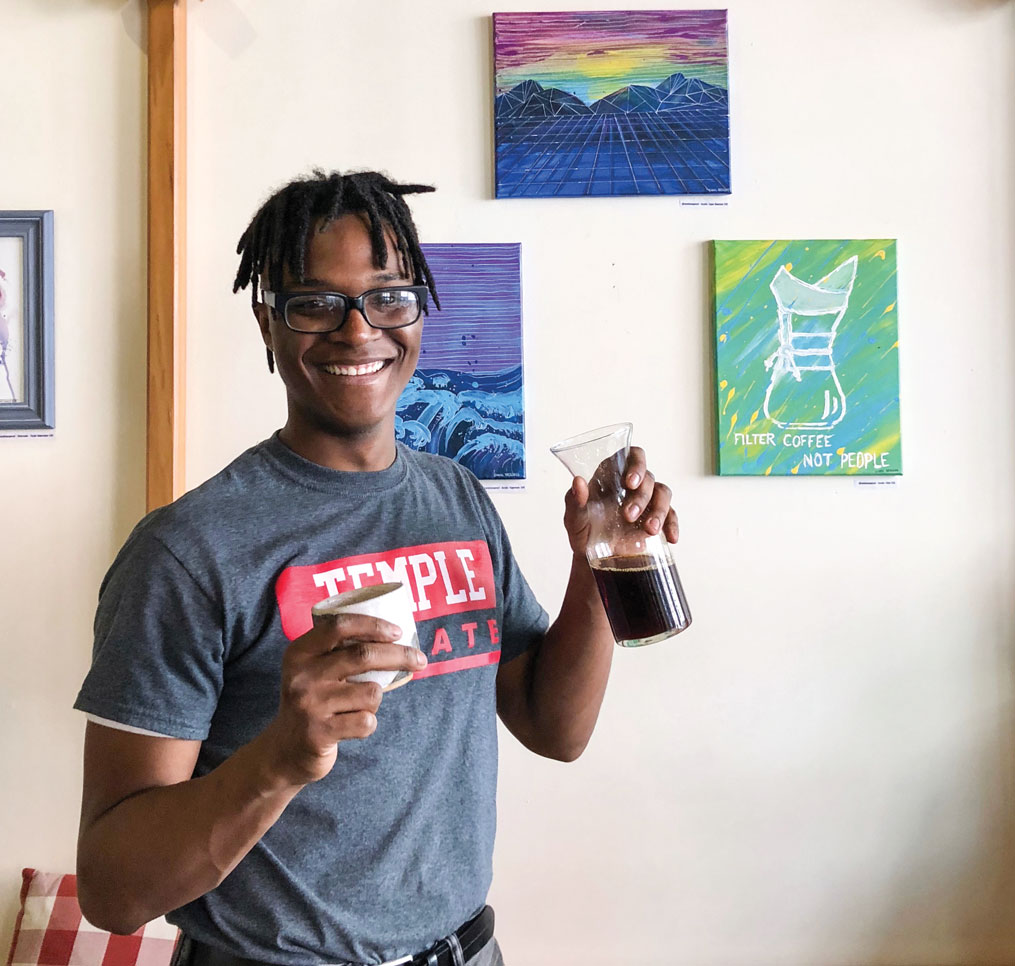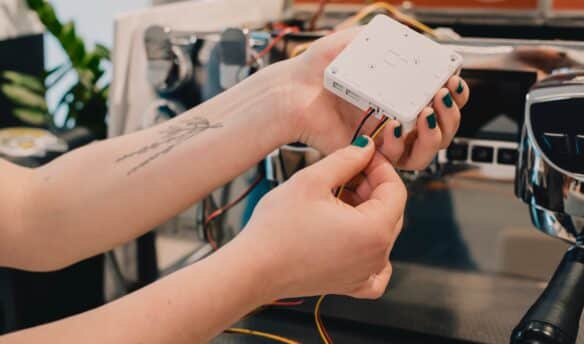Jordan (left) and Ren stock the shelves at Square One Coffee Roasters. Photo courtesy of Square One Coffee Roasters
[W]hile coffee is a magical beverage in and of itself, it’s always been more than just a drink. Throughout history, coffee has acted as a catalyst for communal gathering spaces where people from all walks of life can get together, collaborate, and simply enjoy each other’s company.
Within the coffee industry, many honor that legacy by working to provide safe spaces for people of all identities, on either side of the counter. Ensuring that café spaces stay safe and productive requires more than just good intentions; it requires positive systems guaranteeing that no matter what happens, everyone involved knows exactly what to do to protect themselves, their peers, and their guests. In this piece, I’ll outline five steps to create a safer and more productive café space.
1. Create a Strong Harassment Policy
In order to make sure service staff—especially those of marginalized demographics—are able to protect themselves against verbal and physical harassment, it’s important to craft a comprehensive and specific harassment policy.
“You never know what will happen, so having clear ground rules and procedures is key,” says Jess Steffy, co-owner Square One Coffee Roasters in Lancaster, Pennsylvania.
After starting without an on-paper harassment policy and evolving one over time in collaboration with staff, she now considers it to be a crucial part of their company culture.
“As we’ve become more intentional about this, our customer base has become much more diverse,” she says. “I’ve also found that making sure my staff knows their bosses will back them up in situations with difficult customers has been very important to how safe and supported they feel.”
For maximum efficacy, your policy should outline not only what constitutes harassment, but also what steps baristas should take to address the situation safely. It’s important to offer more than one pathway; for instance, one barista might be comfortable asking the patron to leave, while another might be more comfortable using a cue to alert a manager to the situation and extricating themself.
When crafting a harassment policy, make sure to lay out pathways for addressing and reporting harassment not just from customers, but also coworkers and managers.
As Ian Hamilton, employee experience director for Go Get Em Tiger Coffee in Los Angeles, says, “A lot of times when harassment problems become endemic in workplaces, it’s not because harassment policies don’t exist; it’s because they’re unequally applied. Some companies may find it easy to enact their zero-tolerance policy when trying to fire the dishwasher for harassment, but less so when it’s a manager they really like.”
In order to mitigate these biases and dilemmas, it’s important to make sure your policy covers internal conflict and harassment, and outlines clear procedures even (or especially) when the guilty party holds a position of power in the company.
One point that both Hamilton and Kyle Glanville, co-owner of GGET, both emphasize is that neither on-paper nor verbal policy work well in a vacuum; companies need both strong, specific written policy, and an ongoing, present conversation about harassment in order to prevent it as often as possible. Owners and managers must address harassment fairly when it does come up.
2. Add a Complimentary Service Policy
In addition to telling folks exactly what constitutes harassment and how to approach it, it’s helpful to create a service policy outlining your café’s service style and what good service looks like in your shop. This is helpful not just for getting folks on the same page about what service should look like in your shop, but also for protecting staff against retaliatory customer complaints and burnout.
“A service policy outlines expectations for services offered to customers, responsibilities of staff members, what to do when something comes up that is not specifically outlined,” says Morgan Russell, a tenured coffee professional in the process of opening up a coffee shop in Philadelphia. “When I open my shop, I want my staff to feel safe and in control of the space. The best way I have found to do that is to make sure expectations are clear and communication is open.”
For instance, if you believe that the customer is always right, you can put that in your service policy, but if there are limits—and there usually are—outline them. For instance, if you don’t want your café serving off-menu drinks, you can outline that in your policy and offer baristas an official line to share with customers about why they won’t make those drinks. By putting your expectations on paper, you can also ensure they’re realistic and legally enforceable.
In order to define service standards in a collaborative way, Steffy and the Square One team started a customer service class for all staff members.
“It’s essentially a roundtable discussion on not only customer service, but our company’s culture, values, and goals when it comes to our cafés,” says Steffy.
At GGET, the general service style is to say “yes,” rendering the harassment policy an even more crucial component of their service.
“When you’re encouraged to treat every customer positively and find a way to say yes to every request, it can be incredibly jarring when you come up against a customer who is not engaging in good faith,” says Glanville. “The other side of saying yes whenever possible is that our employees know that they have all the latitude they need to handle tough situations, whether they’re asking another coworker to swap out with them, telling a customer they need to leave, or even calling security.”
3. Use Signage to Set Standards
While it’s easy enough to lay out clear standards for baristas, it’s harder to set clear standards for guests and communicate them effectively. One way to do this is with signage.
A great starting point is to use signage to clearly communicate that you don’t tolerate harassment of any kind, but you can also get more specific about what constitutes unwelcome conduct.
Alchemy Collective in Berkeley, California, hosts a sign reading: “Alchemy Collective asks that you use gender neutral pronouns such as ‘they/them’ to refer to our staff, unless you know their pronouns personally.” Since most worker-owners at the Collective are transgender and/or gender-nonbinary, the sign helps prevent staff from being misgendered by customers.
“From personal experience as a trans-femme, being misgendered by mostly well-meaning customers can be emotionally exhausting and negatively impacts my ability to give good customer service,” says worker-owner Shante Robinson. “The sign also encourages customers to think about gender constructs in ways they might not have otherwise. In the past six months since we’ve had the pronoun sign up, I’ve had the opportunity to talk to several regular customers about non-binary gender identities, in a respectful and consensual manner.”
In the case of Alchemy, the signage doesn’t only prevent unintentional harm, it also helps facilitate a culture where being transgender is the norm, encouraging cisgender customers to get outside of their normal space and enter one where it’s inherently safe to think about gender. Similarly, other cafés can implement signage meaningful to their staff to encourage a safe and productive company culture.
4. Educate Management & Staff on Labor Law Basics
In order to create the safest possible experience for management and staff alike, it’s important to learn about basic labor laws and pass that knowledge on to as much of your team as possible. Many times, managers violate labor laws simply because they don’t know what those laws are.
Learning basic labor laws will outline what constitutes harassment and discrimination at a federal and state level, which regulations govern payment and scheduling, and how certain activities are protected under collective bargaining laws, even though you may not like them. For instance, if an employee gets injured in the workplace, it’s important for everyone involved to understand the implications and be able to take the appropriate next steps. Or, say two employees are talking about their salaries, and a manager overhears and doesn’t want them to. That manager needs to know, for the sake of the company’s liability, that although they may not want the employees to have that conversation, their right to do so is protected by law.
GGET doesn’t yet have formal HR trainings for staff, but it’s something Hamilton wants to implement as soon as possible. As of now, he sits down with every new manager and goes over labor law basics, then works to foster and maintain a close relationship with open lines of communication. Beyond that, “all managers are coached through any sticky situation,” he says. “They know that if they have a problem, I’m here for them.” He’s walked people though filing worker’s comp claims, promotions, and terminations. He’s also working on publishing a common HR issues binder for managers that will live in the shops.
“I don’t think there are really any downsides to people knowing their rights,” says Glanville. “In fact, Ian is the first person encouraging people to take full advantage of their rights. Transparency is how you get the best from people.”
Part of the value Hamilton brings to the HR role is being a former barista and manager in the company—other workers know he has their best interest in mind and will give them any inside HR information when they encounter issues.
“When you hide things, you set yourself up for failure,” he says. “You lose trust of employees and also open yourself up to worse when they do find out. Don’t be shitty in the first place and then you have nothing to hide.”
Not only does educating 360 degrees create the safest possible space, it also helps management by making sure no one is vulnerable to lawsuit.
Steffy is in the process of contracting a local company for some advanced HR and management training for Square One.
“To date, we’ve done team-building workshops for managers and staff, and we’ve begun an ongoing series of mindfulness and implicit bias trainings,” she says. “I absolutely think it’s a benefit to any company to invest in its people, especially its key leadership.”
Since baristas are usually promoted to management without any leadership training, she wants to address that in her own sphere.
“Managing people is a special skill that requires some level of coaching and additional training,” she says.
5. Create Emergency Procedural Guidelines
The policies outlined so far guide employees through many of the challenges they face day-to-day, but it’s also important to have written procedures for emergency circumstances. Below are some arenas this should cover:
- Natural disasters: During a hurricane or snowstorm, when should employees stay home rather than come in? Do employees know the escape plan in the event of an earthquake or fire? Does everyone know what to do in case of an active shooter?
- Medical emergencies: Is there someone in the café who knows CPR on every shift? Does anyone know what to do if a guest chokes, has a seizure, or otherwise collapses?
- Mental health crises: Does your staff know what to do if a stranger has a mental health crisis in the café? It’s important that people have specific instructions that don’t just involve calling 911, which can escalate the situation and put the people involved (including staff members) in danger.
- Non-emergency criminal disruptions: Does your staff know what to do when someone steals the tip jar? What about if someone has been asked to leave, and won’t? Again, it’s important that staff have options outside of calling the police when the situation isn’t truly an emergency, but also don’t put themselves in any harm.
Hamilton and GGET are working with a safety consultancy firm to put together store-specific emergency plans. Over the recent past, they’ve become all too familiar with how to handle worker’s compensation claims, but plan to analyze other gaps in coverage and fill them.
Steffy and the Square One crew have emergency protocols in place, including a list of situations where staff would call 911, another list of situations where they call a non-emergency number, and another set of situations where they’d call the manager or owners.
“We also have some staff with special medical needs, and their emergency protocols are posted (with their permission/insistence) and reviewed with new staff,” she says. In addition to that, they have a local bike patrol available and on-call in their neighborhood to walk staff home if they feel threatened or unsafe.
“Despite never working in a place with formal emergency protocols, I’ve repeatedly had to use the first aid training and conflict resolution experience I gained working in schools,” says Russell, who is working to make sure their coffee shop provides baristas with those tools. “I’ve worked at three coffee shops where the panic button wasn’t actually attached to anything, and where the response to questions about emergency protocols was, ‘We’ve never had that happen’ or ‘That hasn’t been a problem for us.’ Emergencies are the highest-stakes moments that employees have the least experience with. Clear protocols enable employees to react quickly, confidently, and competently, while a lack of protocols can make a situation much worse.”
Review, Discuss, Train & Practice
While these tools can provide a comprehensive safety net for your staff and management, every single one of these tools is only as good as its application. The secrets to their success as pieces of policy are employee review and training, so make sure that before you make them official, you ask willing staff to take a look and add or critique as needed. In addition, once they’re in place, make sure all staff are briefed on them and know exactly what to do. Even better, once you have these in place, you can share them with potential staff members during the interview process to make sure they’re aligned with your company.
Human interactions are unpredictable, but preparedness goes a long way in making sure those who work in and visit your café are safe, protected, and happy. Through thinking intentionally about oft-unspoken standards and taking the time to put them on paper and communicate them outward, you can better ensure that they successfully meet reality and make your café an even better place.
This story was originally published on March 19, 2019 and and has been updated and republished according to current Fresh Cup standards.




















